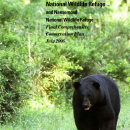What We Do
Wildlife conservation is at the heart of the National Wildlife Refuge System. It drives everything on U.S. Fish and Wildlife Service lands and waters managed within the Refuge System, from the purposes for which a national wildlife refuge national wildlife refuge
A national wildlife refuge is typically a contiguous area of land and water managed by the U.S. Fish and Wildlife Service for the conservation and, where appropriate, restoration of fish, wildlife and plant resources and their habitats for the benefit of present and future generations of Americans.
Learn more about national wildlife refuge is established to the recreational activities offered to the resource management tools used. Using conservation best practices, the Refuge System manages Service lands and waters to help ensure the survival of native wildlife species.
Management and Conservation
Refuges deploy a host of scientifically sound management tools to address biological challenges. These tools span active water management to wilderness character monitoring, all aimed at ensuring a balanced conservation approach to benefit both wildlife and people. At this field station, our conservation toolbox includes:
Prescribed Fire
An active fire management program is housed on the refuge. Seasonal activities include the planning and implementation of controlled burns, and wildfire suppression. The zone program conducts burns 9 months a year, and averages 35 burn days a year. Burns are conducted in a wide range of habitat types, including marsh, grasslands, pocosins, and upland pine and hardwood forest.
Forestry
“A timber management program to include the continuing harvest of select timber species under controlled conditions” is one of the primary objectives of the refuge (Public Law 93-402). Forest management programs are directed towards restoring and enhancing the natural biodiversity of the refuge by restoring or mimicking natural forces that once maintained habitat diversity on the refuge. The primary forest types the refuge focuses management strategies on are Atlantic white cedar, cypress-gum, pine-pocosin, and mesic/mixed-hardwood.
Hydrology
The swamp’s water budget has been drastically altered by man. There are nearly 200 miles of ditches and ditch roads interrupting the natural flow of ground and surface waters which enables a more rapid drain of any precipitation. In an effort to balance that disruption, water control structures are placed at strategic locations in the ditches to help slow the loss of water from the system. Management activities include monitoring water levels, and adjusting and maintaining water control structures.
Wildlife Monitoring and Inventory
The biology program participates in several Service, State, and international monitoring and inventory programs. These include Forest Inventory, Breeding Bird Survey (BBS), the Christmas Bird Count (CBC), Mourning Dove Call-Count Survey, Monitoring Avian Productivity and Survivorship (MAPS), the Bird Point Count, Pollinator counts, NABA Butterfly Count, and the Frog & Toad Calling Survey.
Endangered Species Recovery
The refuge has an active Red-cockaded woodpecker (RCW) recovery program that aims to establish a viable breeding population at Great Dismal Swamp NWR to help prevent extirpation of the species in Virginia, and promote recovery of RCW nationwide. In addition, Great Dismal Swamp NWR’s habitat work restoring pond pine-pocosin and the re-establishment of RCW within this habitat will aid the Service in determining the viability of these habitats as climate change climate change
Climate change includes both global warming driven by human-induced emissions of greenhouse gases and the resulting large-scale shifts in weather patterns. Though there have been previous periods of climatic change, since the mid-20th century humans have had an unprecedented impact on Earth's climate system and caused change on a global scale.
Learn more about climate change affects areas prone to sea level rise.
Comprehensive Conservation Planning
The purpose of a comprehensive conservation plan (CCP) is to specify a management direction for the refuge. The goals, objectives, and strategies for improving refuge conditions -- including the types of habitat we will provide, partnership opportunities and management actions needed to achieve desired conditions -- are considered in the CCP. Nanesmond National Wildlife refuge is an unmanaged satellite refuge of Great Dismal Swamp and the Comprehensive Conservation Plan is a combined document covering the two sites.
Our Services
At this field station we offer the following public services:
- America the Beautiful Parks Passes & Refuge Passes
Annual, Senior, Senior Lifetime, Access, Military/Veteran, and Great Dismal Swamp Refuge-specific passes are available for purchase at the Refuge headquarters office. *Please call ahead to ensure we have the pass you want in stock. Cash or check only. - Every Kid Outdoors 4th Grader Passes
The Every Kid Outdoors (EKO) passes for 4th graders are available at the Refuge headquarters office at no cost. This pass gives free access to Federal lands and waters for 4th graders and their guests. Instructions for getting the pass can be found here. - Special Use Permits
Some uncommon activities such as commercial filming, collecting plants, conducting research, or providing commercial tours requires a Special Use Permit. Please contact refuge staff at GreatDismalSwamp@fws.gov, or 757-986-3705 for instructions on obtaining a permit. - Recreation
The refuge offers year-round opportunities for hiking, biking, boating, fishing, hunting, wildlife observation and photography. - Interpretation and Environmental Education
Our small Visitor Contact Station has information and exhibits. Interpretive signs can be found throughout the refuge.
Law Enforcement
The U.S. Fish and Wildlife Service maintains a law enforcement presence on National Wildlife Refuge lands for wildlife and public safety. Our refuge law enforcement officers protect fish, wildlife, plants and other natural, cultural and historic resources by fostering understanding and instilling in the visiting public an appreciation of refuge resources, laws, and regulations.
Laws and Regulations
Visitor safety is our highest priority. We strive to provide an optimal opportunity to view wildlife in a fun, safe and natural setting. This ensures the integrity of the habitat for our wildlife, as well as an enjoyable experience for visitors. Refuge regulations must be followed at all times while on refuge property.




